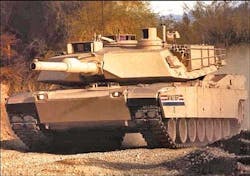Army eyes communications, embedded computing, and electronic warfare upgrades for M1A2 main battle tank
WARREN, Mich., 19 Sept. 2012. U.S. Army combat vehicle experts are looking to engineers at General Dynamics Land Systems in Sterling Heights, Mich., to upgrade the power, communications, embedded computing, electronic warfare, and targeting vetronics systems aboard the M1A2 Abrams SEP v2 main battle tank.
The Army Contracting Command-Warren in Warren, Mich., announced plans Tuesday to award a $383 million sole-source contract to General Dynamics to enhance Abrams tank systems to enable the front-line combat vehicle to keep pace with more modern combat vehicles such as the Ground Combat Vehicle (GCV).
The existing Abrams power systems, furthermore, need improvements to accommodate existing and future electronic systems, Army officials say.
General Dynamics will install upgrade systems aboard a test Abrams tank, and after qualification and approval, Army officials say they will award future contracts to buy upgrade hardware for production tanks.
The Army, in recent years, has made several upgrades to the latest-model Abrams tanks, such as the Tank Urban Survivability Kit (TUSK) and the Commander's Remote Operating weapon Station (CROWS 2), yet these improvements have come at the expense of the tank's space, weight, and power (SWaP) margin, officials say.
The current contract calls for General Dynamics engineers to install several electronics upgrade to the Abrams tank. First, engineers will install the Joint Tactical Radio System (JTRS) handheld manpack and small form fit radios to replace the tank's single-channel ground and airborne radio system (SINCGARS) and Enhanced Position Location Reporting System (EPLRS). The tank's new JTRS software-defined radio will have two-channel communications to support legacy SINCGARS and future radio waveforms.
Next, General Dynamics will install a power generation distribution system with new 1,000-amp alternator, slip ring, hull-processing distribution unit, remote switching modules, and battery monitoring system. These technologies will increase the tank's power to accommodate future electronic technologies. The modified slip rink will be able to pass video and additional power to the turret, Army officials say.
Then the company will install new line-replaceable unit (LRU) and line-replaceable modules (LRM) hardware on the Abrams tank for obsolescence management, SWaP growth, and increased energy efficiency. The LRU/LRM design will capitalize on industry standards for single-board computer interfaces, and accommodate Gigabit Ethernet data communications.
Also on tap for the upgraded M1A2 SEP v2 tank is the latest versions of the counter-remote-control improvised explosive device (IED) electronic warfare (CREW) system.
General Dynamics also will install a new Ammunition Data Link (ADL) to program the tank's M8294E4 advanced kinetic energy and advanced multi-purpose ammunition. The ADL, which passes important platform information to the round, consists of a modified breechblock circuit card, cables, software, and ammunition selection switches.
Next for the upgrade tank is a new auxiliary power unit (APU) to operate on-board systems while giving the tank a reduced probability of detection during silent operations. The APU will save fuel, and reduce the number of batteries on each tank from 12 to six. Upgrades also call for new armor to enable the tank to survive the latest threats.
Army officials say they plan to award a sole-source contract to General Dynamics because the company is the original builder of the tank, and is in the best position to install the upgrades.
Additional information on the upcoming sole-source contract is online at https://www.fbo.gov/notices/6fe91e333528ed9896df7eda966991f6.
For more information contact General Dynamics Land Systems online at http://gdls.com, or the Army Contracting Command at www.army.mil.
Follow Military & Aerospace Electronics and Avionics Intelligence news updates on Twitter

